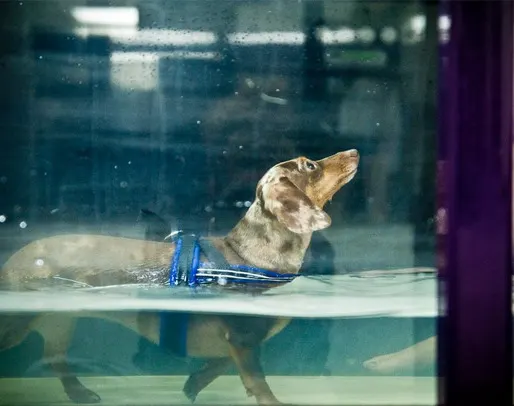
In the Literature
Arena I, Valentini S, Nundini L, Dalmonte T, Spinella G. Physiotherapy treatment of musculo-tendinous disorders of the canine shoulder: a clinical study. Vet J. 2025;313:106379. doi:10.1016/j.tvjl.2025.106379
The Research …
The goals of shoulder rehabilitation are to relieve pain, improve joint mobility, and promote muscle strengthening.1 This retrospective study evaluated a multimodal physiotherapy protocol in dogs with shoulder pathologies to determine which variables (ie, age, sex, weight, degree of lameness, presence of osteoarthritis, modality) positively or negatively influenced recovery times.
Twenty-five dogs were treated with multiple therapies that included laser, pulsed ultrasonography, joint mobilization, massage, stretching, and chiropractic sessions, as well as underwater treadmill work and therapeutic exercise once pain had diminished significantly. Regular evaluations were performed to assess lameness, posture, weight-bearing anomalies, and presence or absence of pain, which would indicate whether therapy was effective.
Complete clinical recovery was achieved in all 25 dogs. No statistically significant differences in outcomes were found based on sex, weight (<48.5 lb [22 kg] vs ≥48.5 lb [22 kg]), or activity level (sporting vs nonsporting dogs); however, additional factors were associated with statistically significant differences in recovery times. Dogs with concurrent osteoarthritis took longer to heal than those without osteoarthritis. Recovery times varied by age: as a group, for every 3 additional years of age, 1 additional rehabilitation session was needed to achieve full clinical recovery. Dogs with second-degree lameness took longer to recover than those with first-degree lameness. There were not enough cases to draw conclusions about the other lameness categories (ie, third-degree, fourth-degree).
Only 2 dogs required >4 months of therapy to achieve full clinical recovery; both were diagnosed with tendinopathies affecting the biceps brachii and supraspinatus muscles, along with associated osteoarthritis.
… The Takeaways
Key pearls to put into practice:
Sporting and working dogs commonly experience shoulder injuries, especially dogs participating in high-impact sports (eg, agility, flyball), in which there is increased stress on muscle, tendon, and ligament structures.2
Biceps brachii and supraspinatus tendinopathies are the most frequently reported soft tissue injuries within the shoulder region.3
Canine rehabilitation speeds up functional recovery times, improves joint function, stimulates healing of the musculotendinous system, and reduces pain. A multimodal approach of manual (eg, joint mobilization, massage, stretching, chiropractic sessions, exercise) and instrumental (eg, laser, ultrasonography, underwater treadmill) methods is a fundamental element of effective management of musculoskeletal disease.
Multiple etiologies for the same patient increases expected time to full recovery. In this study, the 2 dogs requiring >16 weeks of therapy were diagnosed with tendinopathies affecting the biceps brachii and supraspinatus muscles, as well as associated osteoarthritis.
You are reading 2-Minute Takeaways, a research summary resource presented by Clinician’s Brief. Clinician’s Brief does not conduct primary research.